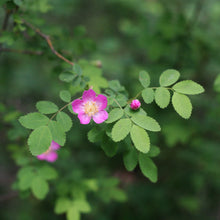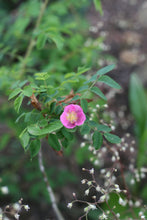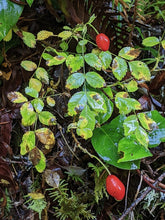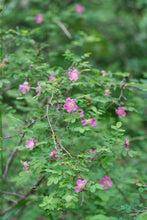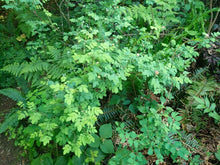
Rosa gymnocarpa
Baldhip rose is a relatively low-growing rhizomatous shrub with fragrant, rosy flowers at the tips of its branches in late spring. The fruits are small, brightly-colored orange to scarlet, pear-shaped “hips” that have lost their leaf-like sepals, making them diagnostically bald. Overall, it is highly attractive, versatile in the landscape, and an excellent habitat plant.
- Plant type/canopy layer: deciduous, med-sized shrub
- Size at maturity: 3-5' tall, 2-8' wide
- Light requirements: full shade, part sun/part shade
- Moisture requirements: dry to moist soil
- Bloom time: April - Aug (May - June in the Portland Metro area)
- Growth rate/ease: medium growth rate, easy to grow
- Wildlife support: flowers attract and provide nectar for hummingbirds, adult butterflies, bees and other insect pollinators; the fruits/hips persist throughout the winter and are eaten by small mammals, birds, and insects; leaves are nesting material for pollinators; steps are hollowed out and used for shelter and overwintering areas for pollinators; overall plant attracts and supports beneficial and pest eating insects, is a host plant and larval food source for native bees and butterflies such as mourning cloaks and gray hairstreak, also forms thickets over time that provide critical shelter and refuge for birds and mammals and are browsed by deer
- Native habitat/range: common in dry to moist open forests from southern British Columbia to the southern California coast in the west, to northern Idaho and western Montana in the east. Portland Plant List - yes.
- Special features & uses: wildlife favorite; supports hummingbirds; landscape uses include pollinator gardens, woodland gardens, erosion control and habitat hedgerows; a medicinal tea can be made from the young leaves, decoction of the bark used as an eyewash, and chewed leaves on bee stings; the hips can be used as beads by children and other wild artisans
Gardening with Baldhip Rose: Baldhip rose is sometimes known as dwarf rose because of its small stature. Yes, standing 3-5ft tall makes it one of the smaller native shrubs! It can grow in a range of sun and moisture conditions, but prefers part-sun and drier soils, making it a charming woodland plant and an excellent choice for your conifer understory. It will spread by rhizomes, forming habitat-friendly thickets over time and acting as an effective privacy barrier or the low layer of a native hedgerow.
Photo Credits 1, 2, 5 (flower closeups, flowers on branch): Karli Del Biondo, Beatles and Bees
Photo Credit 3 & 6 (spines, in the forest): © giantcicada, some rights reserved (CC-BY)
Photo Credit 4 (fruits/hips): © John A Haskins, some rights reserved (CC-BY)






